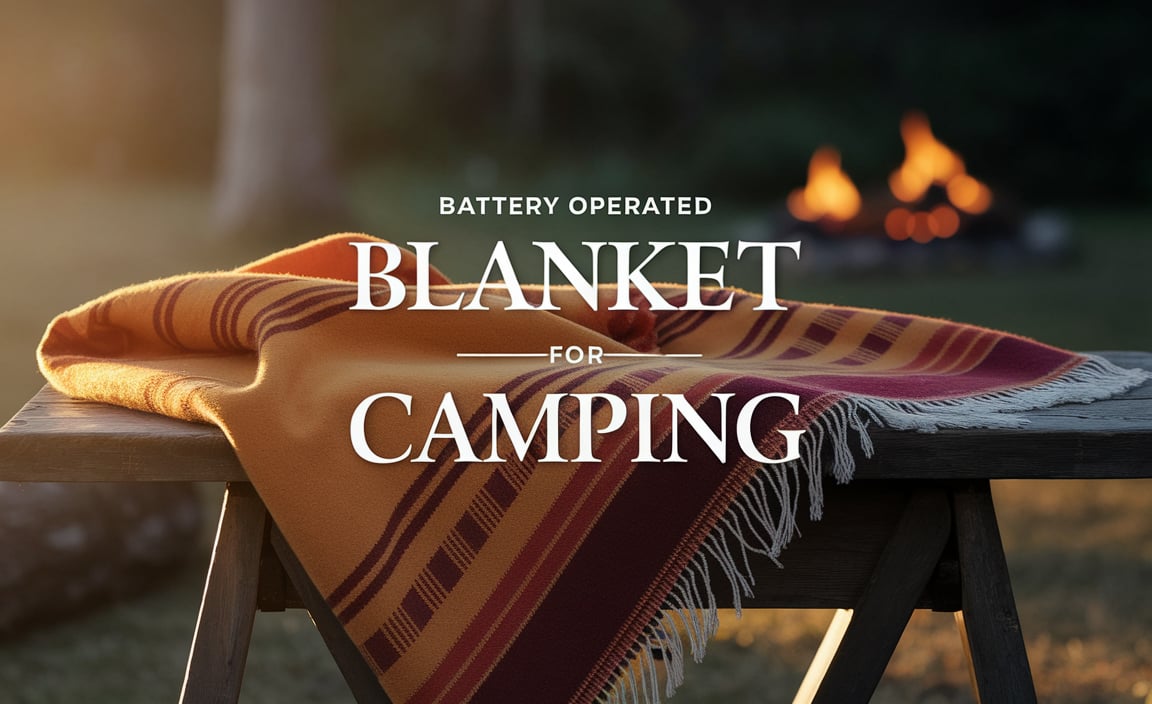Yes, a portable battery pack with an AC outlet is essential for camping, providing reliable power for lights, small appliances, and charging devices, transforming your outdoor experience and keeping you connected.
Camping is a fantastic way to disconnect from the daily grind and reconnect with nature. But let’s be honest, staying completely “off the grid” isn’t always practical or even desired. Imagine this: you’re enjoying a night under the stars, and suddenly, your phone dies, your lantern flickers out, or you wish you could brew a hot cup of coffee with your small coffee maker. Frustrating, right?
This is where the humble, yet mighty, portable battery pack with an AC outlet swoops in to save the day. Think of it as your own personal, portable power station. It’s a game-changer for making your camping trips more comfortable, convenient, and even safer. No more fumbling with weak phone batteries or relying solely on headlamps. Get ready to power up your outdoor adventures!
In this guide, Roy Walker will walk you through everything you need to know about these brilliant devices. We’ll break down what they are, why you absolutely need one for your next campout, how to choose the right one, and simple tips for using it safely. Let’s get your campsite powered up!
Portable Battery Pack AC Outlet: Your Ultimate Camping Companion
Tired of dead phone batteries ruining your photos or a dark campsite making simple tasks difficult? A portable battery pack with an AC outlet is your answer. It’s more than just a power bank; it’s a versatile power solution that brings the convenience of home power right to your campsite.
Whether you’re an avid hiker who needs to keep electronics charged for navigation and emergencies, a car camper who enjoys a few more home comforts, or a family looking for a safe and reliable way to power devices for kids, this gadget is a must-have. Let’s dive into why it’s become an essential piece of camping gear.
What Exactly is a Portable Battery Pack with an AC Outlet?
At its core, a portable battery pack with an AC outlet is a large, rechargeable battery stored in a compact unit. What sets it apart from the standard USB power banks most of us are familiar with is its ability to output standard AC power, just like the outlets in your home.
This means you can plug in devices that normally require a wall socket, such as:
- Small portable fans
- Electric coolers or mini-fridges
- Camping lights with AC adapters
- Laptops and tablets
- CPAP machines for medical needs
- Small kitchen appliances like blenders or coffee makers
- String lights for ambiance
These units typically have multiple output ports, including standard USB-A, USB-C, and the all-important AC outlet. They are rechargeable via AC power at home, your car’s 12V outlet, or increasingly, through solar panels, making them incredibly versatile for off-grid use.
Why It’s Essential for Camping: Beyond Just Charging Your Phone
Sure, charging your phone is a big plus. But the benefits of a portable battery pack with an AC outlet go much further, enhancing your entire camping experience:
- Comfort and Convenience: Power a small fan on a warm night, run a portable heater during a chilly evening, or keep your coffee maker brewing. It elevates your campsite from roughing it to comfortable living.
- Safety and Preparedness: Reliable power means you can keep your phone charged for emergencies, power a first-aid kit item like a CPAP machine, or use a brighter, more powerful lantern for better visibility and security.
- Keeping Devices Running: For longer trips or a digital detox that’s not too extreme, you can keep laptops, tablets, or cameras charged, allowing you to document your adventures or stay entertained during downtime.
- Food and Drink Essentials: Power a small electric cooler to keep perishables cold or even a portable blender for refreshing drinks.
- Extended Stays: For multi-day camping trips where access to power is nonexistent, these units can be a lifesaver, especially if you have specific needs for powered medical equipment.
Understanding the Key Components and Specs
When looking at these power packs, a few key terms and specifications will pop up. Understanding them will help you pick the best one for your needs:
- Capacity (Watt-hours – Wh): This is the most crucial spec. It tells you how much energy the battery can store. A higher Wh means more power and longer runtimes. For example, a 500Wh battery can theoretically power a 50W device for 10 hours (500Wh / 50W = 10 hours).
- Output Power (Watts – W):
- Continuous Output: The wattage the battery can consistently provide. This determines what appliances you can run simultaneously.
- Surge/Peak Output: Some devices, like motors in blenders or fridges, need a big burst of power to start. The surge rating indicates the temporary maximum wattage the unit can handle. Ensure this meets your appliance’s needs.
- Inverter Type:
- Pure Sine Wave: This is the best type for sensitive electronics like laptops, medical equipment, and audio gear. It produces clean, stable power that mimics household electricity.
- Modified Sine Wave: This is cheaper but can cause issues with sensitive electronics, sometimes making them hum, overheat, or not work at all. It’s usually fine for simple resistive loads like basic lights or heaters.
- Ports: Look for a good mix of AC outlets, USB-A, and USB-C ports to cover all your charging needs. USB-C Power Delivery (PD) is great for fast-charging modern devices.
- Recharge Time: How long does it take to fully recharge the battery? Some can be recharged overnight via AC, while others support faster charging or solar input.
- Portability: These can range from relatively lightweight units under 10 lbs to heavier, more powerful models over 30 lbs. Consider how you’ll transport it.
Choosing the Right Portable Battery Pack for Your Camping Style
Not all portable power stations are created equal. Your choice depends on what you plan to power and for how long. Here’s a breakdown to help you decide:
For the Light Camper (Phone, Lights, Small Gadgets)
If your primary needs are charging phones, tablets, and running LED camping lanterns, you don’t need the biggest, most powerful unit. Look for:
- Capacity: 150Wh – 300Wh
- Output: Enough to power your devices. A single AC outlet and a few USB ports will likely suffice.
- Weight: Generally lighter and more portable (under 15 lbs).
- Price: More budget-friendly.
Example Use Case: Keeping phones charged, running a small fan or LED strip lights for a weekend trip.
For the Comfort Camper (Fans, Laptops, Small Appliances)
If you enjoy a bit more comfort and need to power devices that draw more energy, like laptops, a portable fan for extended periods, or a small electric cooler, you’ll need more capacity and power.
- Capacity: 300Wh – 600Wh
- Output: A higher continuous wattage (e.g., 300W-500W) and a decent surge capacity. Multiple AC outlets and USB-C PD ports are highly beneficial. Pure sine wave output is recommended.
- Weight: Moderate (15 lbs – 30 lbs).
- Features: Consider multiple charging inputs (AC, car, solar) for flexibility.
Example Use Case: Running a laptop to edit photos or work, powering a fan overnight, keeping a small cooler running, or charging multiple devices simultaneously.
For the Serious Outdoors Person (CPAP, Mini-Fridge, Multiple Devices)
If you need to power medical devices like a CPAP machine, run a more substantial appliance like a mini-fridge, or power many devices for an extended period, you’ll need a robust unit.
- Capacity: 500Wh and above, often exceeding 1000Wh for larger units.
- Output: High continuous wattage (500W-1000W+) and significant surge capacity. Multiple AC outlets are a must. Pure sine wave is essential for sensitive equipment.
- Weight: Can be heavier (30 lbs+), often featuring built-in handles or even wheels.
- Durability: Look for rugged designs that can withstand outdoor conditions.
- Solar Charging: Integrated or compatible solar charging is vital for extended off-grid use.
Example Use Case: Running a CPAP machine through the night, keeping a full-size cooler cold for days, powering multiple cameras, laptops, and phones on a long expedition.
Table: Comparing Power Station Needs by Camping Type
Here’s a quick comparison to help you visualize:
| Camping Type | Primary Needs | Recommended Capacity (Wh) | Recommended Output (W) | Key Features |
|---|---|---|---|---|
| Light Camper | Phones, lights, basic charging | 150 – 300 | 100 – 200 | Compact, lightweight, 1-2 USB ports, 1 AC outlet |
| Comfort Camper | Fans, laptops, small appliances, multiple devices | 300 – 600 | 300 – 500 (Pure Sine Wave) | Multiple USB/USB-C, 1-2 AC outlets, solar charging option |
| Serious Outdoors/Van Life | CPAP, mini-fridge, multiple high-draw devices | 500+ (often 1000+) | 500+ (Pure Sine Wave, high surge) | Robust, multiple AC/USB-C, fast charging, durable, solar ready |
Getting Started: Setting Up and Using Your Portable Power Station
Once you’ve chosen your portable battery pack, getting it ready for your trip is straightforward. Here’s what you need to know:
Step 1: Fully Charge Your Power Station Before You Go
This might seem obvious, but it’s the most important first step. Plug your power station into a wall outlet at home and let it charge until it reaches 100%.
Tip: Check the manufacturer’s manual for recommended charging times and methods. Some units can also be charged via your car’s 12V outlet while driving, but this is usually slower.
Step 2: Understand Your Device’s Power Consumption
Before you plug something in, it’s helpful to have a rough idea of how much power it uses. Most appliances will have a label indicating their wattage (W). For example:
- LED Camping Lantern: 5-15W
- Smartphone: 5-20W (USB), 30-65W (USB-C PD)
- Laptop: 45-100W
- Small Fan: 20-50W
- Electric Cooler (small): 50-100W (can be higher when compressor starts)
- CPAP Machine: 30-60W
You can use this wattage to estimate how long your power station will last. Divide the total Wh capacity of your power station by the wattage of the device you want to run. For instance, a 500Wh battery powering a 50W fan would theoretically last 10 hours (500 Wh / 50 W = 10 hours).
Important Note: This is a theoretical maximum. Real-world usage is often less due to inefficiencies in power conversion, battery health, and device draw fluctuations. A good rule of thumb is to expect about 80-90% of the calculated runtime.
Step 3: Connecting Your Devices
Simply plug your devices into the appropriate ports on the power station:
- AC Outlet: Plug in your appliance with an AC plug, just like you would at home. Ensure the appliance’s wattage does not exceed the continuous or surge wattage rating of your power station.
- USB-A Ports: Use standard USB cables to charge phones, tablets, cameras, and other USB-powered gadgets.
- USB-C Ports: Ideal for newer devices. If the port supports Power Delivery (PD), it will charge compatible devices much faster.
Step 4: Monitoring Power Usage
Most portable power stations will display remaining battery percentage and/or estimated runtime. Keep an eye on this to manage your power effectively throughout your trip.
Step 5: Recharging on the Go (Optional but Recommended)
If you plan to be out for an extended period, consider bringing a compatible solar panel. This allows you to recharge your power station using sunlight, extending its usability significantly. Ensure the solar panel’s output voltage and wattage are compatible with your power station.
For more information on solar chargers and their integration, check out resources from organizations like the National Renewable Energy Laboratory (NREL), which provides insights into solar energy technologies.
Safety First: Keeping Your Camping Power Safe and Reliable
While these portable power stations are designed with safety in mind, there are a few best practices to follow to ensure you and your equipment stay safe:
- Use in a Well-Ventilated Area: Like any battery, they can generate heat. Avoid operating or charging them in enclosed spaces, especially if charging a large capacity near its limits.
- Beware of Water: Most portable power stations are not waterproof. Keep them protected from rain, splashes, and excessive moisture. Consider a waterproof case or placing them under a canopy.
- Don’t Overload the Outlets: Always check the continuous and surge wattage ratings of your power station against the requirements of the devices you want to plug in. Overloading can trip safety cutoffs or, in rare cases, damage the unit.
- Use Approved Chargers and Cables: Stick to the cables and adapters that came with your power station or are officially approved by the manufacturer.
- Handle with Care: Avoid dropping or subjecting the unit to severe impacts, as this can damage the internal battery cells or electronics.
- Store Properly: If storing for extended periods (months), follow the manufacturer’s guidelines for battery storage, which often involves keeping it at around 50-80% charge.
- Understand Lithium-Ion Safety: Most of these units use lithium-ion batteries. While safe when used correctly, extreme temperatures (hot or cold) can affect performance and longevity. Avoid leaving them in a hot car on a summer day.
For general battery safety, the U.S. Consumer Product Safety Commission (CPSC) offers valuable information on safe battery handling and disposal.
Troubleshooting Common Issues
Occasionally, you might run into a small hiccup. Here are a few common issues and solutions:
- Device Not Charging:
- Ensure the power station is charged.
- Check if the device’s wattage exceeds the power station’s output limit.
- Try a different cable or port.
- If using AC, check if the device itself is working by plugging it directly into a wall outlet.
- Power Station Not Charging:
- Ensure the charger is securely connected.
- Try a different wall outlet.
- Check if the AC input port on the power station is clean.
- Follow manufacturer reset procedures if available.
- No Power from AC Outlet:
- Check if the power station is turned on.
- Make sure the AC power is enabled (some units have a separate button for this).
- Verify the device’s wattage is within limits.
- If the unit has a protective cover for the AC outlet, ensure it’s not hindering connection.
Powering Your Camping Essentials: What Can You Run?
Let’s get practical and look at some common camping items and what kind



